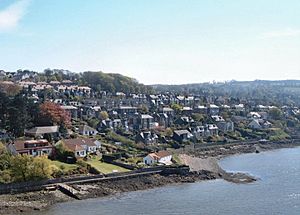Newport-on-Tay facts for kids
Quick facts for kids Newport-on-Tay
|
|
|---|---|
 |
|
| Population | 4,210 (2020) |
| OS grid reference | NO421279 |
| Council area | |
| Lieutenancy area | |
| Country | Scotland |
| Sovereign state | United Kingdom |
| Post town | NEWPORT-ON-TAY |
| Postcode district | DD6 |
| Dialling code | 01382 |
| Police | Fife |
| Fire | Fife |
| Ambulance | Scottish |
| EU Parliament | Scotland |
| UK Parliament |
|
| Scottish Parliament | |
Newport-on-Tay is a small town in Fife, Scotland. It's a popular place for people who work in nearby Dundee to live. The town is located on the Fife Coastal Path, a long walking route. From Newport-on-Tay, you can see the two bridges that cross the River Tay. You can also see the Scottish Highlands in the distance.
Contents
A Look Back: Newport's History
Newport-on-Tay began near a ferry crossing point. This ferry route started a very long time ago, in the 12th century.
In 1715, a new pier and an inn were built. Money for this came from groups in Dundee. Because of this, the settlement was sometimes called "New Dundee." Later, in the 1820s, a new harbour was built by Thomas Telford.
The town grew as a place for people to live who worked in Dundee. Many wealthy business owners and skilled workers from Dundee built fancy homes here.
The local war memorial was built in 1920. It was designed by a famous architect named Sir Robert Lorimer.
Newport-on-Tay used to have two train stations, called East and West. These stations were part of the Newport Railway. Both stations closed in 1969. This happened because the Tay Road Bridge opened in 1966. The bridge made it much easier to travel to Dundee by car. The ferry service to Dundee also stopped when the bridge opened. However, the old ferry buildings are still there today, used as a boat repair yard.
Ancient Discoveries: Archaeology
Near Newport-on-Tay, at a farm called North Straiton, archaeologists found some amazing things. They discovered part of a Bronze Age burial site. This site was used for cremation, which means burning the dead.
They found five human cremations in different pits. About 25 meters away, there was a line of postholes. One of these also had human bone in it. Scientists used radiocarbon dating to find out how old these things were. They learned that they were from the Bronze Age, around 1700 to 2000 BC.
The line of posts was quite big. It might have been connected to the cremations, perhaps as memorials or markers near where the bodies were burned. They also found a piece of a quern stone (used for grinding grain) and some burnt animal bone. This suggests that preparing food was part of the cremation ceremony. Pottery was also found, including a complete small pot and pieces of a larger decorated pot.
Newport Today: What's It Like?
Newport-on-Tay has about 8,000 people living there now. Most of the houses are made of stone and were built before World War II. The town centre has two main streets. Here you can find different shops and three pubs.
The town has one primary school, Newport Primary School. It was built in 1977. Older students go to secondary school in nearby towns. They might go to Madras College in St Andrews or Bell Baxter High School in Cupar. Some students attend private schools like the High School of Dundee or St Leonards School.
You can catch public buses from Newport. Route 77 goes to Dundee, and Route 92 goes to St Andrews. The X54 bus goes to Edinburgh.
Newport has a special connection with Zolotarovo, Ukraine. They have been "twinned" since 2002. This means they have a friendly partnership.
Local Places and Services
Along the High Street, you can find many useful places. There are shops for food and drinks, places for health and beauty, and various other stores. You can also find an art gallery and a sports centre.
Newport has three churches:
- Church of Scotland
- Episcopal Church of Scotland (St Mary's)
- Roman Catholic (St. Fillans)
Another Church of Scotland church, St. Fillans, was taken down in 1981.
Newport-on-Tay and the Arts
Art has always been important in Newport. In 1905, a group called the Tayport Artists' Circle was formed. This group included artists like James Douglas, Anna Douglas, and David Foggie. Their goal was to use art to make the industrial areas better.
Many art teachers from the University of Dundee's Duncan of Jordanstone College of Art and Design have moved to Newport-on-Tay. They love the amazing quality of light there. Famous Scottish artists like John Byrne, Will Maclean, and Marian Leven have connections to the area.
There's also a local community arts centre called The Forgan Arts. It offers classes in different arts and crafts. A new art gallery, the Tatha art gallery, opened in Newport-on-Tay in 2014.
Famous People from Newport
- Sir John Leng (1828-1906) – A politician and publisher.
- John Leng Sturrock (1878-1943) – Also a politician.
- George Ranken Tudhope (1893-1955) – A pathologist, who studies diseases.
- Sir Charles Lambe (1900-1960) – A very high-ranking naval officer, the First Sea Lord. He was born in Dorset but lived and died in Newport.
- Scott Sutherland (1910-1984) – A sculptor, known for making statues.
- Valentine Fleming (1882-1917) – A politician from the Conservative Party.




